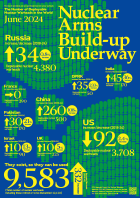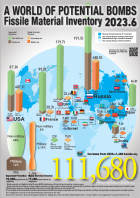Status of World Nuclear Forces
World Nuclear Forces (As of January 2024)
The 9 countries listed below possess a total of 12,121 nuclear warheads, of which 3,904 are operationally deployed.
| State | Number of warheads | Deployed warheads |
| US | 5,044 | 1,770 |
| Russia | 5,580 | 1,710 |
| UK | 225 | 120 |
| France | 290 | 280 |
| China | 500 | 24 |
| India | 172 | – |
| Pakistan | 170 | – |
| North Korea | 50 | – |
| Israel | 90 | – |
| Total | 12,121 | 3,904 |
Source: SIPRI Yearbook 2024 (Stockholm International Peace Research Institute Website)
*The figures show the total estimated nuclear warheads, including deployed (on missiles or bases with operational forces), reserve, and awaiting dismantlement.
World’s nuclear warhead data and world’s fissile material data are available on Nagasaki University’s Research Center for Nuclear Weapons Abolition (RECNA) website.
The Inhumanity of Nuclear Weapons -Realities of the Atomic Bombings-
In August 1945, two single atomic bombs dropped on the cities of Hiroshima and Nagasaki instantly reducing them to rubble, taking more than 210,000 precious lives by the end of that year. At the moment of detonation, fierce heat ray and massive amounts of radiation were emitted in every direction. At the same time, the surrounding air rapidly expanded, generating a super-high-pressure blast. The complex interaction of these three factors amplified the damage. The harm inflicted by the atomic bomb is characterized by massive and instant destruction; indiscriminate mass slaughter. In addition, the aftereffects of radiation are enduring and unpredictable.
The atomic bomb survivors (hibakusha), many of who barely survived, still suffer noticeably from the harmful aftereffects of radiation to this day. While their minds and bodies are in pain, they, together with members of the public and with support from civil society, continue to make their appeal that “no one else should suffer as we have.”
It is of great importance that more and more people throughout the world deepen their understanding of the realities of the atomic bombings, the inhumane nature of nuclear weapons, and the long-term catastrophic consequences that occur on a global scale when used. Given the inhumanity of nuclear weapons, the international community must make every effort to eliminate them as soon as possible.
- Atomic bomb survivor (hibakusha) testimony videos are available to be viewed online at the Peace Database, managed by the Hiroshima Peace Memorial Museum.
- Memoirs (remembrances) of the atomic bombing(s) written by hibakusha, their relatives and acquaintances can be read at the “Global Network,” managed by the National Peace Memorial Halls for the Atomic Bomb Victims in Hiroshima and Nagasaki.
Today’s nuclear disarmament
*Terminology explained below
In 1970, the Treaty on the Non-Proliferation of Nuclear Weapons (NPT) came into force with the objective of preventing the further proliferation of nuclear weapons and promoting nuclear disarmament.
The treaty identifies five countries- US, USSR (now Russia), UK, France, and China- as nuclear-weapon states. It prohibits other signatory states from developing or possessing nuclear weapons and obligates the nuclear-weapon states to negotiate in good faith toward nuclear disarmament as well as general and complete disarmament.
To date, a total of 191 states (*) have joined the treaty. The States Parties to the treaty hold Review Conferences every five years to review implementation of the treaty and look forward to next steps. However, negotiations among the nuclear-weapon states to advance nuclear disarmament have not made much progress. The confrontation between nuclear- and non-nuclear weapon states is ongoing, and tensions between nuclear-armed states are also rising.
(UN website)
*This number includes North Korea, which announced its withdrawal from the treaty in 2003. North Korea now has nuclear weapons. The following four states are non-signatories to the NPT: India, Israel, Pakistan, and South Sudan. India and Pakistan possess nuclear weapons outside of the NPT regime. Israel, too, is widely believed to possess nuclear weapons (outside of the NPT regime), but is deliberately ambiguous regarding its nuclear weapons status- never officially admitting nor denying having nuclear weapons.
The Treaty on the Prohibition of Nuclear Weapons (TPNW) is the first multilateral treaty to clearly and fundamentally state that nuclear weapons are subjected to total prohibition under international law. It prohibits its States Parties from developing, testing, producing, acquiring, possessing, stockpiling, using, or threatening to use nuclear weapons. Its preamble refers to the unacceptable suffering of and harm caused to the victims of the use of nuclear weapons (hibakusha), as well as the catastrophic humanitarian consequences that would result from any use of nuclear weapons. The treaty also obliges its States Parties to provide assistance to individuals affected by the use or testing of nuclear weapons, as well as to conduct environmental remediation in areas under its jurisdiction contaminated as a result of the testing or use of nuclear weapons.
Against the backdrop of globally increasing awareness about the inhumanity of nuclear weapons in international society and in the midst of stagnation on nuclear disarmament among nuclear-armed states, in July 2017, the TPNW was adopted at the UN with 122 nations voting in favor. The treaty opened for signature in September 2017, the number of states ratifying the treaty reached 50 in October 2020, and the treaty entered into force in January 2021.
From now on, securing the TPNW’s greater influence in international society and promoting its universalization by involving the nuclear-armed states and their allies will be of great importance. More specifically, urging the nuclear-armed states and their allies to participate in discussions for effective implementation and development of the treaty and to attend meetings of States Parties as observers, and ultimately, to become States Parties, will be the essential forthcoming challenges.
| Signatories *1 | Parties *2 |
|---|---|
| 94 | 73 |
*1 Signatories: states that have signed the treaty
*2 Parties: states that are (or soon to be) legally bound by the treaty
(UN website)
Glossary of treaty-related terms
- Nuclear disarmament refers to the act or effort of limiting, reducing, and eliminating nuclear weapons. In many cases, it is negotiated between two or more states, and implemented by taking necessary measures to limit, reduce and abolish nuclear weapons in accordance with a bilateral, multilateral or international agreement or treaty among its parties.
- Entry into force: When a treaty enters into force after fulfilling certain requirements or conditions stipulated in its text, it comes to have legal force and effect and becomes a legally binding instrument for its members (called “States Parties”).
- Signature by a representative of a state expresses the nation’s basic agreement to the treaty’s text and its willingness to continue to the final procedure of ratification (or approval/acceptance).
- Ratification is an international act by a state expressing its formal and final consent to be legally bound to a treaty.
Two major treaties are introduced here- but there are many more international laws that addresses the restriction, limitation, reduction or elimination of nuclear weapons, whether directly and indirectly.
Examples of other (nuclear) disarmament treaties: Nuclear-Weapon-Free Zone (NWFZ) Treaties, New START Treaty, Comprehensive Nuclear-Test-Ban Treaty (CTBT) (has not yet entered into force), Fissile Material Cut-off Treaty (FMCT) (proposed: yet to be negotiated), Intermediate-Range Nuclear Forces Treaty (INF) (expired), Antarctic Treaty, Outer Space Treaty, Sea-bed Treaty.
Reference
The following websites are great sources to learn and understand the international circumstances surrounding nuclear weapons, the current status of nuclear disarmament, and the realities of the atomic bombings of Hiroshima and Nagasaki.
- Research Center for Nuclear Weapons Abolition, Nagasaki University RECNA Website
- Hiroshima Peace Memorial Museum Permanent Exhibitions
- Hiroshima Peace Memorial Museum Peace Database
- The National Peace Memorial Halls for the Atomic Bomb Victims in Hiroshima and Nagasaki Global Network
- UN Office for Disarmament Affairs



